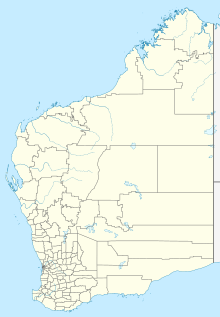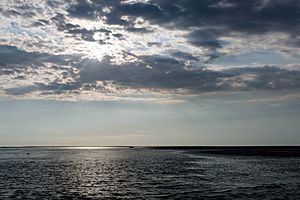Camden Sound facts for kids
Camden Sound is a large area of water in the Indian Ocean. It is found in the Kimberley region of Western Australia. This sound is surrounded by groups of islands. These include the Bonaparte Archipelago to the north-east and the Buccaneer Archipelago to the south-west. Montgomery Reef is also to the south.
Camden Sound is very important for many sea animals. It is a special breeding area for different types of whales. It is home to the world's largest group of humpback whales. The Lalang-garram / Camden Sound Marine Park helps protect this area. It is managed by the Government of Western Australia's Department of Biodiversity, Conservation and Attractions. This marine park is about 300 kilometres (186 miles) north-east of Broome. It is the second largest marine park in Western Australia, after Shark Bay. As of 2020, there are plans to combine this park with three others. They will form one big marine park called Lalang-gaddam Marine Park.
Contents
History of Camden Sound
Aboriginal people have lived and fished in the Camden Sound area for a very long time. They were here long before European settlers arrived in Western Australia.
Captain Phillip Parker King "discovered" Camden Sound on August 15, 1821. He was on his ship, HMS Bathurst. He named it Camden Bay after John Pratt, 1st Marquess Camden.
A small settlement called Camden Harbour was built within the sound. However, it did not last very long.
Today, three Aboriginal groups have special rights to the land and water in the marine park area. These groups are the Dambimangari, Uunguu, and Mayala people. The Dambimangari claim covers most of the park.
What Camden Sound Looks Like
Camden Sound has many islands around it. To the north-east are the islands of the Bonaparte Archipelago. The largest island here is Augustus Island. To the south-west, you will find the Buccaneer Archipelago. This group stretches all the way to Sunday Island. To the south is Montgomery Reef.
Some other islands and places in Camden Sound include Champagny, Byam Martin, and the Heywood Islands. These are to the west. To the south, you'll find Bumpus Island, Rice Rocks, Sampson Inlet, Deception Bay, and Prior Point.
There are no roads to Camden Sound. The closest town is Kalumburu, which is 268 kilometres (167 miles) to the east.
The area used to be a valley that filled with water, called a drowned valley. The islands you see are the tops of old rock formations made of basalt and sandstone.
Like the rest of the Kimberley coast, Camden Sound has very big tides. The water level can change by up to 11 metres (36 feet) during a spring tide.
Why Camden Sound is Important for Nature
Camden Sound is known worldwide as a vital place for humpback whales. It is a crucial breeding and calving area for a group of humpback whales called Breeding Group D. This group has about 22,000 whales, making it the largest humpback whale population in the world.
Baby whales are born and fed in the warm, tropical waters of Camden Sound. They stay here for several months. This gives them time to grow strong enough for their long journey. They then travel back to the Antarctic to feed in the summer.
Camden Sound is also home to many other sea creatures. These include Australian snubfin dolphins, blue whales, pygmy killer whales, pilot whales, and bottlenose dolphins. The area also has many coral reefs. These reefs are full of hard and soft corals, turtles, molluscs, fish, and other marine invertebrates.
The Marine Park
The Kimberley Marine Park is a protected area managed by the Australian Government. It covers a large part of the ocean outside the state marine parks. This area helps protect the ocean from south of King Sound to almost the top of the North Kimberley Marine Park.
Camden Sound Marine Park
The Camden Sound Marine Park was the first of four new marine parks in the Kimberley region. It covers a huge area of 7,062 square kilometres (2,727 square miles). In October 2009, Donna Faragher, Western Australia's Environment Minister, announced its creation. This was mainly to protect the area where humpback whales give birth and raise their young.
This park is the second largest in Western Australia. It connects to the Prince Regent National Park. Important places like Montgomery Reef, Champagny Island, and St George Basin are part of it.
The Lalang-garram / Camden Sound Marine Park is managed together by the Western Australian Government and the Dambimangari people. This is the first marine park in Australia to be managed jointly. The Dambimangari people chose the name "Lalang-garram." In their Worrorra language, it means "the saltwater as a spiritual place as well as a place of natural abundance."
Both the government and the Dambimangari people want to protect the area. They want to make sure their "saltwater country" stays healthy. They also want to prevent any plants or animals from becoming extinct. Many animals and ecosystems here are very important to the local people, especially the humpback whale.
The park is divided into different zones. Each zone has different rules about what activities are allowed. For example, there is a special whale sanctuary zone. Other zones protect areas around Champagny Islands and Montgomery Reef. Some areas are closed to certain types of fishing.
The park's plan focuses on two main things:
- Habitats: This includes rocky shores, platforms, and areas with seagrass.
- Special Species: This means animals that need extra protection, like humpback whales. It also includes fish that people catch.
Most visitors access the park by joining a cruise. These cruises often travel between Broome, Wyndham, Darwin, and Cairns.
New Marine Parks (2020)
In 2016, there was a plan to combine the Camden Sound Marine Park with others. These included the Lalang-garram / Horizontal Falls Marine Park and the North Kimberley Marine Park. Together, they would form the Great Kimberley Marine Park. This park would cover about 30,000 square kilometres (11,583 square miles) of coastal waters.
In 2020, a new plan was released. It suggested combining four marine parks into one large park called the Lalang-gaddam Marine Park. This new park would include Lalang-garram / Camden Sound, Lalang-garram / Horizontal Falls, North Lalang-garram, and a new park called Maiyalam Marine Park. All these areas are in the sea country of the Dambeemangarddee people.
The new Maiyalam Marine Park will add 47,000 hectares (116,140 acres) to the protected marine areas in the Kimberley. The larger goal is to create 5,000,000 hectares (12,355,269 acres) of new national and marine reserves in Western Australia. The new spelling "Lalang-gaddam" is the correct way to say the word. "Maiyalam" means "between islands" or "a gap through."
The new Maiyalam Marine Park is located off the north-western coast of King Sound. It also includes the area around Macleay Island. The Lalang-gaddam Marine Park will border other marine parks. These include the proposed Mayala Marine Park to the south-west and the North Kimberley Marine Park to the north-east.



